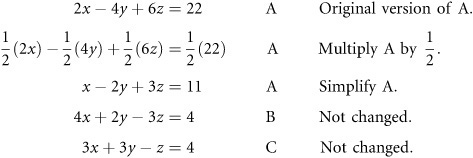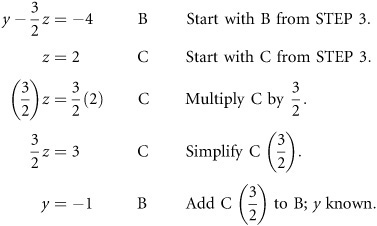Systems with Three Variables
When you deal with systems of three equations with three variables, you extend the addition and multiplication activities you perform when you work with systems of two equations with two variables. The goals and procedures remain the same. Your task is to move through the equations, multiplying and adding so that you can express the equations so that they identify the values of the constituent variables.
To examine how to work with a system of three equations with three variables, consider this system:
| 2x - 4y + 6z = 22 | A |
| 4x + 2y - 3z = 4 | B |
| 3x + 3y - z = 4 | C |
To make it easier to identify the equations, you can associate them with letters of the alphabet. As you go, the letters allow you to continue to identify the equations as you rewrite after performing operations involving addition and subtraction on them.
STEP 1
For starters, the first goal involves examining the system to see if there is a convenient way to isolate the x variable. Toward this end, you multiply equation A by
![]() , eliminating the coefficient of x.
, eliminating the coefficient of x.

If you examine equation B, you see that you can multiply the new form of equation A by -4 to obtain an equation that eliminates the x variable from equation B. Along the same lines, if you multiply the new form of equation A by -3, you obtain an equation you can use to eliminate the x variable from equation C. Here is the form your work assumes:
| x - 2y + 3z = 11 | A | From the previous rewriting. |
| 4x + 2y - 3z = 4 | B | Original version of B. |
| -4x + 8y - 12z = -44 | A | Multiply A by -4. |
| 10y - 15z = -40 | B | Add A(-4) to B. |
Then you attend to equation C:
| 3x + 3y - z = 4 | C | Original version of C. |
| -3x + 6y - 9z = -33 | A | Multiply A by -3. |
| 9y - 10z = -29 | C | Add A(-3) to C. |
STEP 2
You now have a system of equations in which you have eliminated the x variable from two of the equations. You now need to isolate the y and z variables in the same way. Here is the system of equations as you have rewritten them thus far:
| x - 2y + 3z = 11 | A | Coefficient of x is 1. |
| 10y - 15z = -40 | B | Added A to remove x. |
| 9y - 10z = -29 | C | Added A to remove x. |
To proceed with the isolation of y in equation B, you multiply equation B by
![]() . In this way, you reduce the coefficient of y in equation B to 1. Here is the form your work assumes:
. In this way, you reduce the coefficient of y in equation B to 1. Here is the form your work assumes:

You can now put this rewritten version of B to work to eliminate the y variable from equation C. To accomplish this, you multiply B by -9 because 9 is the value of the coefficient of y in equation C. Here is how your work proceeds:

To solve equation C for z at this point, you use these steps:

STEP 3
The system now takes this form:

Given that you have identified the value of z, you can now use your knowledge to eliminate the z variable from equations A and B. To accomplish this, you first work with equation B. Then you work from there to equation A.
Beginning with equation B, then, given that the coefficient of z is −
![]() , you multiply equation C by
, you multiply equation C by
![]() to arrive at an equation you can add to B to eliminate z.
to arrive at an equation you can add to B to eliminate z.
Here is how your work proceeds:

This then provides you with the value of y. At the same time, it remains for you to eliminate the z variable from equation A. To eliminate the z variable from equation A, you repeat much of the activity you just performed. This time around, you consider that the coefficient of z in equation A is 3. Given this value, you multiply equation C by -3 to arrive at an equation you can subtract from equation A to remove the z variable from equation A. Here is how your work proceeds:
| x - 2y + 3z = 11 | A | Start with A from STEP 3. |
| (-3)z = -3(2) | C | Multiply C by -3. |
| -3z = -6 | C | Simplify C. |
| x - 2y = 5 | A | Add C to A. |
STEP 4
Now that you have eliminated the z variable from equation A, your system of equations takes the following form:
| x - 2y = 5 | A | x not yet isolated. |
| y = -1 | B | y is known. |
| z = 2 | C | z is known. |
You have yet to isolate x. When you accomplish that task, you then have all the values for the three variables. From your work so far on equation B, you know that y = -1, so you can use this knowledge to eliminate the y variable from equation A in a ready fashion. Accordingly, the coefficient of y in equation A is -2, so you can multiply equation B by 2 to arrive at an equation you can add to equation A to eliminate the y variable. Here is how you proceed:
| x - 2y = 5 | A | Start with A from STEP 4. |
| 2y = (2)- 1 | B | Multiply B by 2. |
| 2y = -2 | B | Simplify B. |
| x = 3 | A | Add B to A. |
STEP 5
With the isolation of x, you now have values for all three of the variables in the equation. You can show them as follows:
| x = 3 | A | x is known. |
| y = -1 | B | y is known. |
| z = 2 | C | z is known. |
To write the solutions for the original set of equations, you can employ parentheses in which you list the solutions in the order x, y, and z:
(3, -1, 2)
Exercise Set 11.6Solve the systems of equations.
|
